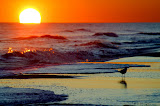
06 September 2008
28 September 2007
How To Improve Digital Print Tonality
Sunday, 12 August 2007
By Ctein
I'd been holding this item for a future column, but the recent article on B&W digital photography makes it pertinent. One of the commenters perceptively noted that digital prints often (if not always) lacked the subtle tonality and fine gradation of traditional prints.
I'm not sure precisely where this occurs in the process. My hunch is that it has less to do with the camera and more to do with the 8-bit drivers, displays, and printers, and the RIPping engines that drive those printers. But really, I'm just waving my arms here. I don't know. In the next few years, we'll see fully 16-bit native drivers in the major applications and devices, and then will see if I'm right.
In the meantime, digital prints can have a slightly flat aspect to them; subtle variations in tone and color, "texture" or "snap" if you will, seem to get suppressed.
Bill Atkinson taught me a nice Photoshop fix for that. It works so well, and it's so easy to do, that I now use it on every photograph I print out.
Here's what you do. Pull up Unsharp Masking. Set the Amount for somewhere between 8 and 15% (depending on taste, subject, and printer). Set the Radius for around 60 pixels. Set the Threshold to 0. Let'er rip!
Here are the settings I used to produce the illustration below. This is a bit on the strong side, but I want to make sure the results are clearly visible on your display. For normal printing, you'll probably like a percentage value close to 10%.
You'll find that subtle tonal and color separation has been improved and increased without a commensurate increase in overall contrast. It's a real miracle worker.
On the left is the image before Unsharp Masking. On the right is the same image afterwards. The overall contrast really isn't any different, but there's an impressive improvement in the fine tonal separation.
Here's what's going on. Unsharp masking increases the difference between the target pixel and the surrounding pixels. With a small Radius it has little effect on areas of uniform tone. But when it hits a boundary, where there are both bright and dark pixels, it makes the bright pixels brighter and the dark pixels darker than the average. Consequently, there's an edge enhancement that makes the picture look sharper.
When you use it in the fashion I've just described, it doesn't see edges; it sees the average tonality over a broad area. If the target pixel differs from that average, it increases the difference by a small amount. Subtle variations in tone and texture get enhanced.
There may be a slight increase in the total value range of the photograph, because highlights are frequently small areas that fall within the 60-pixel radius. So you want to apply this filter before you do your last bit of curves fine-tuning to the image tone and contrast. Other than that, it doesn't really matter when you do it.
Try it; you'll like it!
________________
Ctein
Featured Comment by Nuno de Matos Duarte: "Here's another useful tip. I've been using the Local Contrast technique for a while and I've notice that it tends to blow the highlights and the shadows. So try this variation: use the values of Unsharp Mask suggested by Ctein in an Adjustment Layer. Go to: Layer Style > Blending Options. Go to: Blend If > This Layer, and split the cursors to the following values: 51/70 and 185/215. Create an Action to make it easy in the future. In my opinion, this technique works even better this way."
Posted at 08:29 PM | Permalink | Comments (29) | TrackBack (0)






